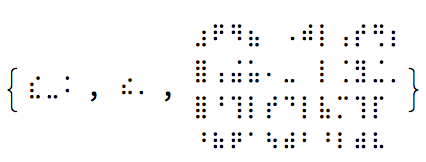46
3
Cut a boolean matrix in 4x2 blocks and render them as Braille characters U+2800...U+28FF.
[[0,1,0,0,1,0],
[1,0,0,0,0,0],
[1,0,0,0,1,0],
[1,1,1,1,0,0]]
⣎⣀⠅
Pad with 0-s if dimensions are not multiples of 4 and 2.
[[0,1,0],
[1,0,0],
[1,1,1]]
⠮⠄
Usual golfing rules apply, flexible on input format. Output should either have the structure of a matrix or look like a matrix, e.g. list of strings; single string with newlines.
Hint: chr(0x2800 + 128*b7 + 64*b6 + 32*b5 + 16*b4 + 8*b3 + 4*b2 + 2*b1 + b0) is the dot pattern
b0 b3
b1 b4
b2 b5
b6 b7
Larger test:
[[0,0,1,1,1,1,0,0,0,0,0,0,0,1,1,0,0,0,0,1,1,1,0],
[0,1,1,1,1,1,1,0,0,0,0,0,1,1,1,0,0,0,1,1,1,1,1],
[0,1,1,0,0,1,1,1,0,0,0,1,1,1,1,0,0,1,1,0,0,0,1],
[1,1,0,0,0,0,1,1,0,0,0,0,0,0,1,0,0,1,1,0,0,1,1],
[1,1,0,0,0,1,1,0,0,0,0,0,0,0,1,0,0,1,1,1,0,1,0],
[1,1,0,0,0,0,0,0,0,0,0,0,0,0,1,0,0,0,1,1,0,0,0],
[1,1,0,1,1,1,1,1,1,0,0,0,0,0,1,0,0,0,0,1,0,0,0],
[1,1,0,1,1,1,1,1,0,0,1,1,0,0,1,0,0,1,1,1,1,1,1],
[1,1,0,1,1,1,1,0,0,1,1,1,1,0,1,0,1,1,1,1,1,1,0],
[1,1,0,1,0,1,1,0,1,1,0,1,1,0,1,0,0,0,0,1,1,0,0],
[1,1,0,0,0,1,1,0,1,0,0,0,1,0,1,1,0,0,0,1,1,0,0],
[1,1,0,0,0,1,1,0,1,0,0,0,1,0,1,1,1,0,0,1,1,0,0],
[0,1,1,0,1,1,1,0,1,0,0,1,1,0,0,1,1,0,0,1,1,0,0],
[0,1,1,1,1,1,0,0,1,1,1,1,1,0,0,1,1,0,1,1,1,0,0],
[0,0,1,1,1,0,0,0,0,1,1,1,0,0,0,0,1,0,1,1,1,1,0]]
⣰⠟⠻⣦⠀⠠⠾⡇⢠⡞⢛⡆
⣿⢠⣬⣥⠄⣀⠀⡇⢈⣻⣈⡀
⣿⠘⢹⡇⡞⠙⡇⣧⡉⢹⡏⠀
⠘⠷⠟⠁⠳⠾⠃⠘⠇⠾⠧⠀

Congrats on second challenge. – Adám – 2017-08-27T10:49:12.747
5Better description: you have a 2D array of Boolean values whose rows represents the horizontal raster lines of a black-and-white (1 bit per pixel) frame buffer or graphics canvas. Encode all of the 4x2 rectangular blocks of this canvas into Unicode Braille characters. To handle fractional blocks at the edges, pad the canvas's width to a multiple of 2, and height to a multiple of four, with zeros (or otherwise ensure the equivalent output, treating the data as if it were so padded). – Kaz – 2017-08-27T17:44:57.487
3@Kaz I don't know, I personally really appreciate how concise this post is. IMO, not a lot of clarity would be added by writing any more (besides a few small clarifications like noting that the height should be a mult of 4 and the width of 2); your suggestion is harder for me to read than the current post. – Quelklef – 2017-09-10T19:43:54.210